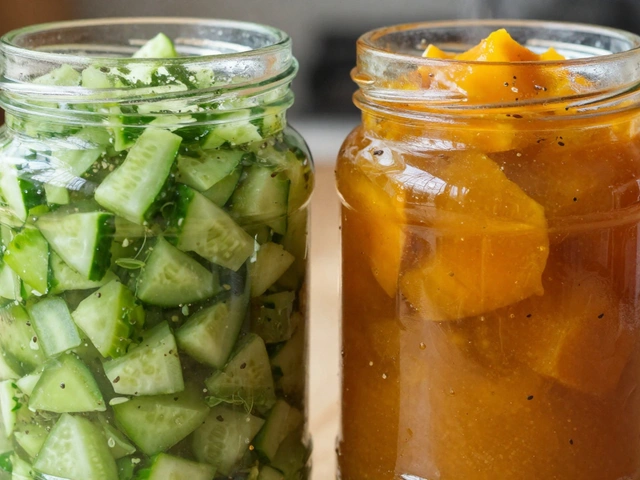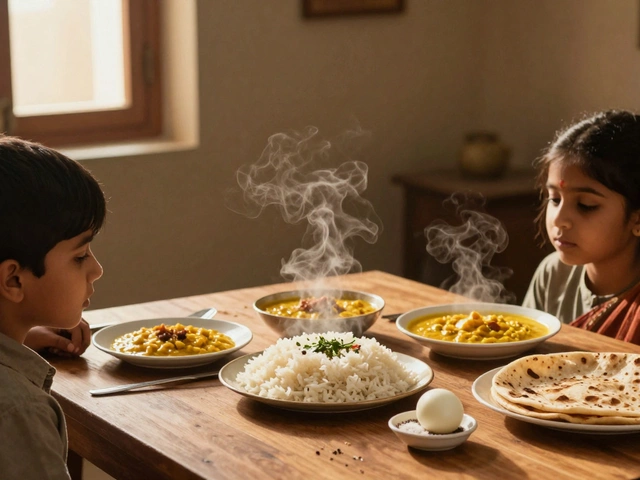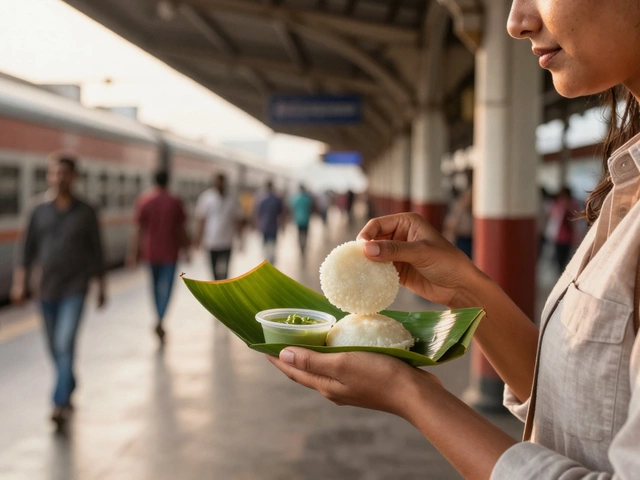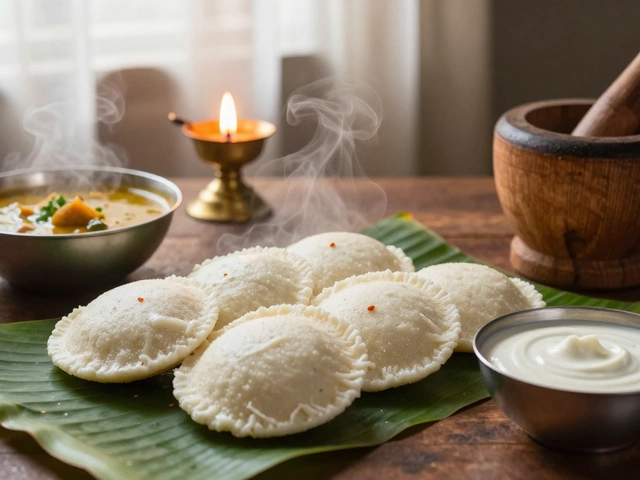You don’t need a dozen specialist ingredients to make a curry that tastes like it came from a proper kitchen. The real secret is technique: how you treat your spices, onions, and heat. Get those right and even a simple chickpea curry can sing. Miss them and the fanciest garam masala won’t save a dull, watery sauce. Here’s a straight, no-fuss guide to the moves that matter, why they work, and how to fix things when they go sideways.
TL;DR: The seven secrets behind great curry flavor
Short on time? Nail these and you’re 80% of the way there.
- Bloom spices in fat. Whole seeds first, then ground. Thirty to sixty seconds until fragrant unlocks fat‑soluble aroma molecules (as Harold McGee explains in On Food and Cooking).
- Take onions past pale. Aim for deep gold to light brown, not translucent. That caramelization builds body and natural sweetness, stopping watery, flat curries.
- Bhunao the paste. After adding garlic, ginger, and ground spices, cook until the paste darkens and the oil starts to separate back out. This 3-5 minute step erases raw spice taste (Camellia Panjabi writes about this extensively).
- Balance the “five S’s.” Salt, Spice (heat), Sour, Sweet, Savory (umami). Taste and adjust at the end; that’s where the magic happens.
- Pick the right base. Tomato = tangy; yoghurt = light and creamy; coconut milk = rich and mellow; nut pastes = luxe. Add yoghurt off the heat to avoid splitting.
- Manage liquid and heat. Simmer uncovered until glossy and thick enough to coat a spoon. Rest the curry 10-30 minutes, or better yet, overnight, for flavors to marry.
- Finish bright. A squeeze of lemon/lime or tamarind, a pinch of garam masala, and fresh herbs or a ghee tadka at the end lift everything.
Keep those curry tips in mind, and you’ll taste the difference tonight.
Step-by-step: A reliable method you can use for nearly any curry
Think of this as a flexible blueprint. It’s not tied to one cuisine or region; it’s about technique that works across chicken, veg, beans, paneer, or seafood.
Base ratios (serves 4):
- 2-3 tbsp neutral oil or ghee
- 1 large onion (about 200 g), finely chopped
- 1-1.5 tsp fine salt to start (you’ll adjust later)
- 3 cloves garlic + 1 thumb-sized piece ginger, minced or made into a paste
- 2 medium tomatoes (300 g) chopped, or 200 ml passata, or skip and use yoghurt/coconut depending on the style
- 2-3 tbsp spice blend (see below) plus 1 tsp garam masala to finish
- 400-500 g protein or veg (e.g., chicken thigh, chickpeas, cauliflower, prawns, paneer)
- 300-500 ml liquid (water/stock/coconut milk), added gradually
- Acid to finish: 1-2 tsp lemon/lime juice or 1-2 tsp tamarind
- Prep smart. Chop onions evenly so they brown at the same pace. If using chicken, toss it with 1 tsp salt, 1 tsp grated ginger, 1 tsp grated garlic, and 1-2 tsp yoghurt while you prep-salt plus a little acid helps it stay juicy (Madhur Jaffrey often uses light yoghurt marinades). Pat prawns dry and salt lightly; they cook last and fast.
- Bloom whole spices. Heat oil on medium. Add whole seeds (e.g., 1 tsp cumin, 1-2 green cardamoms, a small cinnamon piece, a few cloves, or 1/2 tsp mustard seeds for South-leaning styles). When they crackle and smell nutty-about 30-45 seconds-move on. Don’t burn them; blackened spices taste bitter.
- Brown the onions properly. Stir in onions and a pinch of salt. Cook on medium, stirring every minute until deep golden-usually 10-15 minutes on a home hob. If they threaten to catch, splash in a tablespoon of water and scrape the fond. Deep gold means sweetness and body; stop at pale and your curry will taste thin.
- Add garlic and ginger. Stir for 30-60 seconds until fragrant. Raw garlic tastes harsh; cooked just right, it turns mellow and savory.
- Bhunao the spice paste. Lower heat slightly. Add ground spices mixed with a little water to form a loose paste (so they don’t scorch): common combo is 2 tsp coriander, 1 tsp cumin, 1/2-2 tsp chilli powder (to taste), 1/2 tsp turmeric, optional 1 tsp paprika for color. Stir and fry 2-5 minutes until the paste darkens, smells toasty, and the oil starts to separate. This is the make-or-break step for depth (Camellia Panjabi calls it essential; you’ll see chefs do this automatically).
- Build the base. Add tomatoes if using. Fry until they break down and the oil peeks through again, 5-8 minutes. For yoghurt-based curries, cut the heat to low and whisk in room-temp yoghurt a spoonful at a time to temper, then bring back to a gentle simmer. For coconut milk, add it later to avoid curdling during aggressive frying.
- Liquid and simmer. Add your protein/veg and enough water/stock to just cover. Bring to a gentle simmer. Chicken thigh needs 20-25 minutes; chickpeas (canned) about 10-15; prawns 3-5; paneer 5-8 to warm through. Keep the lid off if you want it to thicken; on if you need to keep it saucy.
- Reduce to glossy. You’re aiming for a sauce that clings to the spoon and looks shiny. If you see little pools of oil rising, that’s a good sign you’ve cooked it enough for a rich style. For lighter curries, stop earlier.
- Finish bright. Turn off the heat. Adjust salt. Add 1 tsp garam masala, squeeze in lemon/lime or stir tamarind, and shower with coriander. Taste again. If it’s flat, it usually needs salt and acidity. If it’s harsh, it needs a minute’s rest or a teaspoon of sugar.
- Rest. Let it sit 10-20 minutes before serving. Next day, it will taste even better; diffusion and rehydration of spices make flavors rounder (Nik Sharma writes about how acidity and time change flavor perception in The Flavor Equation).
Spice blend options:
- Classic: coriander, cumin, turmeric, chilli powder, plus garam masala to finish.
- South-leaning: add mustard seeds, curry leaves, black pepper, fenugreek, and coconut elements.
- Goan/Coastal: cumin, coriander, chilli, turmeric, with vinegar or tamarind and coconut.
- Earthy veg curries: add fennel, black cardamom, a pinch of kasuri methi (dried fenugreek leaves) at the end.
Protein notes:
- Chicken thigh likes medium heat and time; breast is leaner and can dry out-add it later and cook gently.
- Prawns and fish go in at the end; overcook them and they turn rubbery.
- Paneer benefits from a quick sear in a nonstick pan; add near the end to keep it soft.
- Veg like cauliflower and potatoes need a head start; par-cook or cut smaller so the sauce doesn’t over-reduce while they soften.
Heat management tips:
- Induction hobs run hot and responsive; use medium to medium-low for the bhunao stage.
- Electric coils lag; adjust early so you don’t scorch spices.
- A tablespoon of water is your friend if the paste starts to catch-deglaze, scrape, and keep going.

Examples: three fast frameworks you can cook tonight
Use these as templates. Swap proteins or veg, keep the method.
Homestyle chicken curry (onion‑tomato base, 40-50 minutes)
- Marinade: 500 g chicken thighs with 1 tsp salt, 2 tsp yoghurt, 1 tsp each ginger/garlic. Rest 15 minutes.
- Bloom 1 tsp cumin seeds in 2.5 tbsp oil; add a small cinnamon stick and 2 cloves if you like.
- Brown 1 large onion to deep gold. Stir in garlic and ginger.
- Bhunao: 2 tsp coriander, 1 tsp cumin, 1 tsp kashmiri chilli (mild), 1/2 tsp turmeric with a splash of water. Fry until oil peeks out.
- Add 2 chopped tomatoes; cook until thick and shiny.
- Add chicken; stir to coat. Add 350 ml water, simmer 20-25 minutes.
- Finish: salt to taste, 1 tsp garam masala, a knob of butter or 1 tsp ghee, coriander, and lemon.
Goan‑style prawn curry (coconut & tamarind, 25 minutes)
- Warm 2 tbsp oil. Bloom 1/2 tsp mustard seeds and a few curry leaves until crackly.
- Soften 1 chopped onion to pale gold; add 2 garlic cloves and 1 tsp grated ginger.
- Spices: 1.5 tsp coriander, 1 tsp cumin, 1/2 tsp turmeric, chilli to taste. Fry briefly with a splash of water.
- Add 200 ml coconut milk and 150-200 ml water; simmer 5 minutes.
- Stir in 1-2 tsp tamarind paste until balanced.
- Add 400 g prawns; simmer 3-5 minutes until just opaque. Finish with coriander and adjust salt/acidity.
Chana masala (weeknight chickpeas, 35 minutes)
- Heat 2 tbsp oil. Bloom 1 tsp cumin seeds.
- Brown 1 large onion. Add garlic and ginger.
- Bhunao: 2 tsp coriander, 1 tsp cumin, 1 tsp chana masala blend or 1 tsp garam masala later, 1/2 tsp turmeric, chilli to taste.
- Add 300 g chopped tomatoes or passata; cook until jammy.
- Add 2 cans drained chickpeas and 250-350 ml water. Simmer 15 minutes.
- Finish with 1-2 tsp lemon juice or 1 tsp amchoor (dried mango powder), garam masala, coriander. Salt to taste.
Want something lighter? Skip tomatoes and finish with yoghurt (tempered off the heat). Want richer? Fold in a quick cashew cream (soak 1/4 cup cashews in hot water 10 minutes, blend with a splash of water) and simmer briefly.
Cheat-sheets, fixes, and FAQs
Here’s the practical stuff you’ll use every time-pantry lists, quick ratios, and a fix-it map when things go wrong.
Pantry checklist (small quantities beat stale bulk)
- Whole: cumin seeds, coriander seeds, black pepper, green cardamom, cinnamon, cloves, mustard seeds, fenugreek seeds, bay leaves, dried red chillies, curry leaves (frozen keep their aroma well).
- Ground: chilli powder (pick a heat level you like), turmeric, coriander, cumin, paprika, garam masala, black pepper.
- Bases: onions, garlic, ginger, tomatoes/passata, coconut milk, plain whole-milk yoghurt, tomato paste.
- Acids/sweeteners: lemon/lime, tamarind paste, vinegar (for certain coastal styles), sugar or jaggery.
- Fats: neutral oil (rapeseed/groundnut), ghee or butter for finishing.
Quick timing cues
- Whole spices: 30-60 seconds until fragrant and crackling.
- Onions: 10-15 minutes to deep gold on medium heat; stir every minute.
- Bhunao (spice paste): 2-5 minutes until darker and oil resurfaces.
- Tomato reduction: 5-8 minutes to go from wet to jammy and glossy.
Flavor balancing map (the five S’s)
- Flat or dull? Add salt first. If it perks up but still feels heavy, squeeze in lemon/lime.
- Too hot? Dilute with more sauce (add tomatoes, coconut, or stock), then a pinch of sugar and a splash of cream/yoghurt.
- Too sour? A pinch of sugar or a bit more fat smooths it out.
- Too bitter (burnt spices)? Fish out burnt bits if you can, add a knob of butter/ghee, and a little sweetness; in bad cases, strain and start a quick fresh temper (tadka) to layer over the top.
- Too salty? Add unseasoned cooked potatoes/veg, or a splash of coconut milk; acid can distract, but true saltiness needs dilution plus volume.
- Too thin? Simmer uncovered to reduce, or blend a ladle of sauce/veg and stir back for body.
Decision tips
- If you want bright, tangy curry: tomato base + finish with lemon.
- If you want rich and mellow: coconut base + finish with ghee.
- If you want light, creamy without heavy fat: yoghurt base, tempered off heat.
- If using delicate protein (fish/prawns): cook sauce first; add protein last.
- If you only have curry powder: use it, but bloom briefly and finish with garam masala for aroma.
Mini‑FAQ
- Why do curries taste better the next day? Time lets spices diffuse and harsh edges mellow. Starches rehydrate and thicken the sauce. Many cooks plan for leftovers for this reason.
- How do I stop yoghurt from splitting? Use full-fat yoghurt at room temp. Take the pan off heat, whisk in a spoonful at a time to temper, then return to a gentle simmer. Don’t boil hard after adding.
- Can I just use curry powder? Yes. Use 2-3 tbsp for a pot that serves four. Bloom it briefly with oil and aromatics, then build your base. Add a small amount of fresh garam masala at the end to lift aroma.
- What’s the best oil? Neutral oil (rapeseed/groundnut) for blooming; ghee or butter to finish. Olive oil’s flavor fights with warm spices for many styles.
- Do I need fresh spices? Fresher is better. If a jar smells weak, it will taste weak. Grind small batches of whole spices if you can; in a damp coastal climate, store nuts and ground spices in small jars and top up often.
- Restaurant‑style silky sauce at home? Blend the onion‑tomato base until smooth, return to the pan, then finish with a ghee tadka and garam masala. For British‑Indian‑restaurant style, some cooks use a pre‑made base gravy; blending gets you most of the way.
- How spicy should I go? Separate heat from flavor. Start mild with chilli powder or fresh chillies, and build. You can always add heat later via a chilli oil drizzle or sliced green chilli on top.
- Leftovers and rice safety? Cool rice and curry quickly, refrigerate within an hour, and reheat until steaming hot. The UK Food Standards Agency advises reheating rice only once.
Troubleshooting by scenario
- Beginners, 25 minutes, minimal kit: Pick chickpeas or paneer. Fry onions to deep gold, stir garlic/ginger, add 2 tsp coriander + 1 tsp cumin + chilli + turmeric, then a tin of tomatoes. Simmer with chickpeas 10-15 minutes. Finish with lemon and garam masala.
- Cooking for kids or low‑heat eaters: Use mild chilli powder or skip it. Lean on paprika for color, coriander/cumin for flavor. Add a spoon of yoghurt or coconut at the end to soften edges.
- Batch cooking for the week: Make a big onion‑tomato base and freeze in portions. Reheat and customize: coconut + prawns day one, chickpeas day two, paneer day three. Finish fresh each time with acid and herbs.
- On induction/electric hobs that run hot: Do the spice paste on medium‑low, add a splash of water if it sticks, and take your time on onions. Control beats speed here.
- Accidentally burnt the spices: Stop heat, remove burnt bits, add a fresh tadka (heat a little oil/ghee with whole cumin/mustard and curry leaves) and pour over to restore aroma.
- Sauce split after adding yoghurt/coconut: Lower heat, whisk in a tablespoon or two of cold water, and gently stir. If it’s still grainy, blend briefly-it won’t be perfect, but the texture will improve.
Tiny evidence-backed tips that stack up
- Oil carries aroma. Many key spice molecules are fat‑soluble; without enough fat during blooming, your curry smells muted (McGee).
- Salt early, adjust late. Early salt helps onions brown and seasons the base; final salt and acid fine‑tunes perception of flavor (Sharma).
- Cook until you see change. Oil separating is a reliable visual cue that the paste is fried enough-kitchens from Delhi to Goa rely on it (Panjabi).
- Fresh garam masala goes in at the end. It’s a finishing aroma, not a base fry spice. Early, it just fades.
If you remember nothing else: give onions time, fry your spice paste till it smells toasty and looks glossy, and finish with something bright. That’s the quiet, repeatable “secret” that makes good curry easy to hit on a busy weeknight-and even better when you’ve got a lazy Sunday and a pot that can simmer away while you do anything else.





